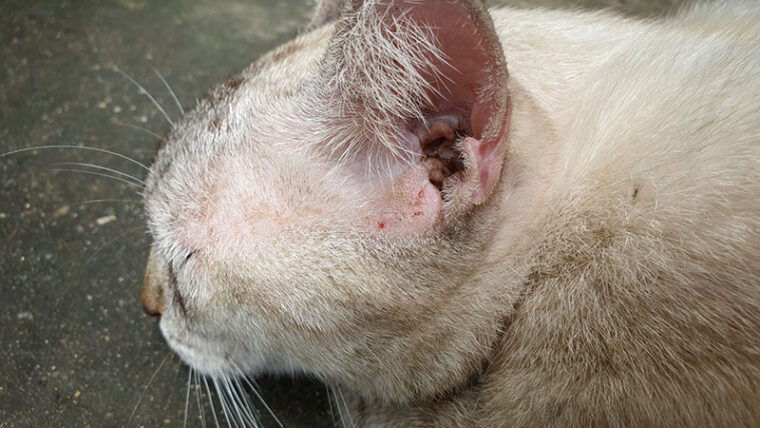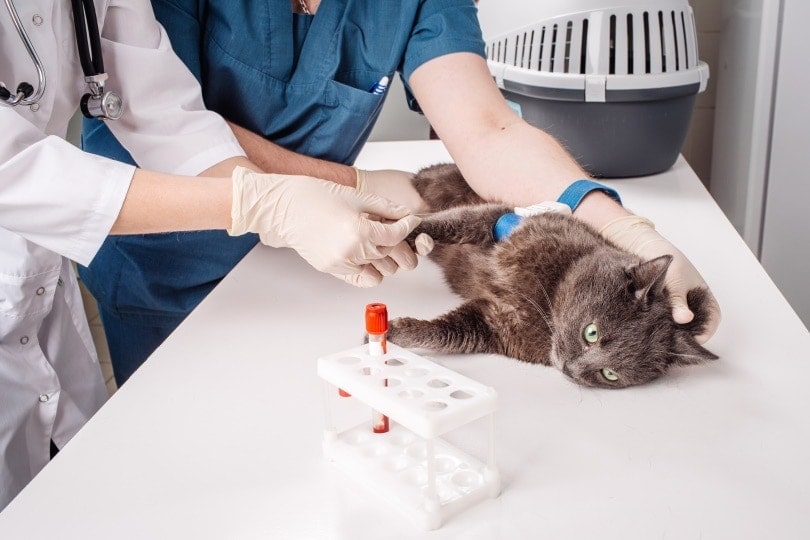
Click to Skip Ahead
Yeast infections are an uncommon skin disease among cats, but all breeds are susceptible to this condition, which can cause your cat to have loss of hair, greasiness of fur, redness on skin, and itchiness. Like all cat parents, we want our cat to be happy and free of discomfort. So, what can we do when our cat experiences this condition?
In this article, we explore what happens when a cat has a yeast infection, including its signs and possible causes, as well as how to best care for them.
What is Malassezia Dermatitis in Cats?
Malassezia pachydermatis is a yeast that is commonly found on the skin and ears of cats. As such, cats normally have a controlled amount of this yeast on their bodies. The yeast infection occurs when an abnormal growth occurs, causing inflammation on the skin known as Malassezia dermatitis.
Malassezia dermatitis occurs secondary to an existing infection, and is also known to be triggered by allergies. Other factors that can affect the growth of the yeast include hormonal, environmental, and possible congenital factors. Malassezia are opportunistic in nature, taking advantage of the changes and imbalances on the skin allowing them to proliferate.
The disease varies in severity, ranging from a more severe thickening of the skin resembling elephant skin to a mild itch. Although this yeast infection is more common in dogs, it is also known to occur among all the different breeds of cats as well.

What Are the Signs of Malassezia Dermatitis?
Malassezia dermatitis is a skin condition, so it can occur anywhere on the skin. Signs of this yeast infection that can be found around the ears, paws, face, neck, elbows, groin, and rear include:
Should you find any of these signs on your cat’s skin, consult with your veterinarian for the proper treatment. When in doubt, it is always recommended to consult. Better to be safe than sorry!
Diagnosis
Proper diagnosis of Malassezia dermatitis can be performed through testing, as well as a thorough history of your cat’s health by your veterinarian. A complete physical examination will be performed, followed by laboratory tests—which may include blood tests, urinalysis, and culture of the causative organisms by obtaining small tissue samples through skin cytology. This can be performed by viewing the specimen under a microscope to properly identify the organism.

What Are the Causes of Malassezia Dermatitis?
Malassezia dermatitis generally occurs secondary to an existing condition. This yeast infection can occur from a variety of factors including allergies, hormonal imbalances, environmental factors, and genetic or hereditary predispositions. Any change in the skin condition caused by these factors can cause the Malassezia fungus to grow and proliferate, causing the dermatitis infection and inflammation.
Some of the most common allergic reactions of this yeast infection caused by food include greasy skin or seborrhea. Trauma to the skin and bacterial infections can also cause the proliferation of Malassezia. Amongst various coat and skin types of different cat breeds, there are some breeds that are more pre-disposed to organism, including Sphynx and Rex breeds.
Because of this, it is important to maintain a healthy diet, as well as promote good hygiene for your cat. After all, the best way of beating a disease is through prevention in the first place!
How Do I Care for a Cat with Malassezia Dermatitis?
Treatment for Malassezia dermatitis Is fairly simple, with topical therapy considered the primary approach. The goal for treatment is to reduce the number of yeast and bacteria present on the skin, while also limiting their growth.
Topical Treatment

Medications applied to your cat’s skin, such as topical creams, sprays, lotions, wipes, or antifungal shampoos can be prescribed by your veterinarian to ease irritation, remove scales, and aid in healing lesions brought about by the skin infection. These topical medications can also aid in relieving discomfort and resolving odor from existing lesions. These antifungal agents include azoles, such as miconazole, ketoconazole, clotrimazole, and climbazole.
Oral Treatment
Oral medication can be prescribed for more severe signs of yeast infection, in addition to topical medication to speed up treatment by controlling the fungal and bacterial growth on the skin.
Symptom Control
For cats with existing and underlying medical conditions—such as bacterial infections, hormonal imbalances, parasites, and allergies—the primary condition must be treated ,while controlling the symptoms of the yeast infection. These entail use of proper medical management specifically targeting the underlying pathology. Once the primary pathology is resolved, the chances of recurrence of Malassezia dermatitis is greatly reduced.
Prognosis
Overall, the prognosis and recovery time for cats with Malassezia dermatitis is good. Factors to take into consideration for the prognosis include the underlying cause of the yeast infection—making management of the primary pathology the priority, while also treating the symptoms of the fungal infection. Early detection is important to begin management as soon as possible before symptoms get worse.
Frequently Asked Questions (FAQs)
Is Malassezia dermatitis contagious?
The Malassezia fungus is generally not considered contagious to both other animals and humans. Nevertheless, proper infection control is still recommended through good hygiene and proper cleaning of the lesions.
Why does my cat’s yeast infection keep recurring?
Consult with your veterinarian, as your cat may be experiencing allergic reactions to certain foods, environmental factors, or parasites. Should your cat experience continuous recurrence of Malassezia dermatitis, it is important to pinpoint what the underlying condition is that’s causing the fungi to proliferate and abnormally grow on your cat’s skin for proper treatment.
How many days does it take to treat a yeast infection?
With the proper treatment, mild infections can resolve within a few days. More severe infections may take up to a week or two. Consult with your veterinarian as soon as possible for immediate treatment, before signs and symptoms become worse.

Final Thoughts
Malassezia dermatitis is an uncommon skin disease among cats. Though not considered to be a cause for alarm, they can be rather uncomfortable for your cat. To prevent your cat from catching the disease, make sure you feed them a proper and balanced diet and keep both their bodies and environment clean.
Consult with your veterinarian as soon as you suspect any signs of infection to minimize any discomfort or worsening of symptoms. As cat parents, the last thing we want is our cat to be uncomfortable—and it is our responsibility to ensure they are comfortable, happy, and beautiful!
See Also:
- Ehrlichiosis in Cats: Signs, Causes & Treatment (Vet Answer)
- Histiocytoma (Skin Tumor) in Cats: Our Vet Explains Causes, Signs & Care
Featured Image Credit: RJ22, Shutterstock








